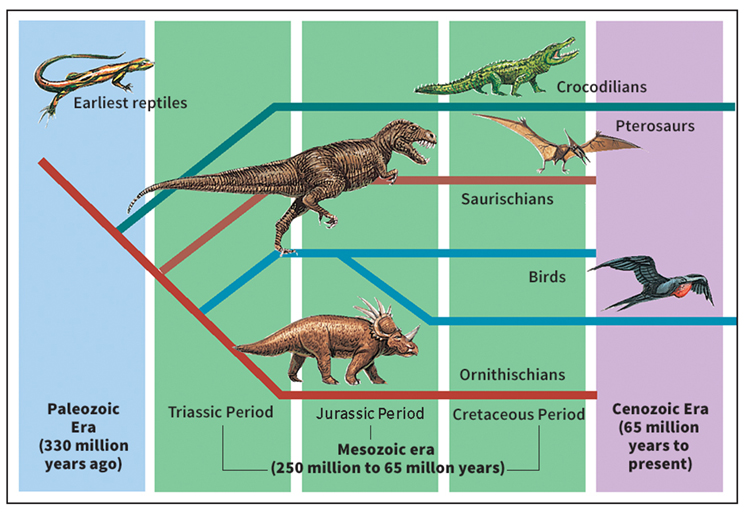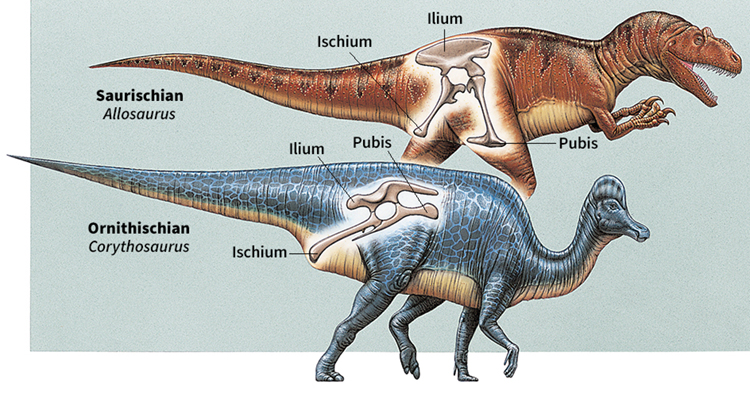Tyrannosaurus is a fearsome example of a saurischian (reptile-hipped) dinosaur. Credit: © Science Picture Company/SuperStock
For decades, dinosaurs have been grouped into two broad categories: long-necked sauropods and meat-eating theropods (along with birds) in one group, and the remaining plant-eaters, such as Stegosaurus, Triceratops, and Iguanodon, in the other. In March, a group led by Matthew G. Baron from the University of Cambridge in the United Kingdom challenged that view. They published their findings in the prestigious scientific journal Nature.
To study dinosaur relationships, paleontologists (scientists who study prehistoric life) use a type of analysis called cladistics. In cladistics, researchers evaluate anatomical traits of at least three related species. These evaluations help them construct a cladogram, a kind of family tree illustrating how the species are related to one another. Groups of species that are related to one another are called clades. For dinosaurs, skeletal features are used, such as the absence or presence of a particular bone or a certain feature on a bone.

The accepted dinosaur family tree describes two major kinds of dinosaurs: ornithischians and saurischians. Credit: WORLD BOOK illustrations by George Fryer, Bernard Thornton Artists
For 130 years, paleontologists have grouped dinosaurs into two large, confusingly named clades based on the arrangement of their pelvic, or hip, bones. All tetrapods (animals with four limbs) possess three paired sets of hip bones: two ilia (singular: ilium), two ischia (singular: ischium), and two pubes (singular: pubis). In one group of dinosaurs, the pubes run from the hip socket down and away from the center of the animal, close to the ischia. Because these hips looked similar to those of birds, early paleontologists named the group Ornithischia, which means bird-hipped. But ornithischians are not closely related to birds.

This illustration shows the difference between bird-hipped ornithischians and reptile-hipped saurischians. Credit: WORLD BOOK illustrations by Alex Ebel
In sauropods and most theropods, the pubic bones project straight down from the hip socket or at a slight forward angle. This is closer to the condition seen in other reptiles, so they were included in the clade Saurischia, which means reptile-hipped. In some small theropods, however, the pubis is “reversed,” angling away from the center of the body at an angle similar to the ischium. Birds evolved (developed over time) from these theropods, making them members of the “reptile-hipped” clade, even though they truly have bird hips.
Baron studied 73 dinosaur species and catalogued 457 skeletal characteristics with them. He coded these characters into a computer program, which returned new controversial results. Theropods were found to be more closely related to ornithischians, with sauropods and some primitive meat-eaters remaining in Saurischia. Despite their different-shaped hips, theropods and ornithischians were found to be united by more than 20 unique characters. To refer to the clade, Baron and company revived the name Ornithoscelida (meaning bird-legged), which had been coined by the famous British zoologist Thomas Henry Huxley in 1870. Fortunately for the sake of clarity, birds would be considered bird-legged dinosaurs under this system!
The new placement would resolve some puzzles about the origins of dinosaurs. The earliest known dinosaur skeletons are about 230 million years old and have been found in South America. But still older reptiles that are regarded as the ancestors to dinosaurs have only been found in northern regions far from South America. To further muddle things, footprints widely attributed to early dinosaurs have been found in eastern Europe and are some 5 million to 9 million years older than the South American skeletons. With the proposed reorganization, those earliest-known skeletal remains would be considered early relatives of sauropods, suggesting that the earliest dinosaurs have yet to be discovered somewhere in the Northern Hemisphere.
While the proposed rearrangement would solve some problems relating to the origin of some dinosaur features, it would create problems relating to the origin of others. For instance, sauropods and theropods both had air sacs connected to their lungs. These air sacs had long chambers that tunneled through their bones, making them lighter. Based on the new family tree, the first dinosaur would have had to possess these air sacs. Why would ornithischians lose a trait that was apparently so useful to sauropods and theropods and remains vital to birds today? Scientists will continue studying them to try to answer this puzzling question.
Though paleontologists commended Baron for the meticulousness of his work, they were quick to point out that more data would be needed to convincingly rearrange the family tree. The Saurischia-Ornithischia division has been upheld for decades by dozens of cladistics analyses, so it will take more than one new analysis to convince paleontologists to overturn 130 years of study. But the bird-legged dinosaur clade will have a leg to stand on if more fossil discoveries and cladistic analyses back up Barron’s findings.
Untitled Document Can't view the linked articles? Subscribe to World Book Online

World Book Online delivers a progressive sequence of core databases supported by supplemental
tools, such as language translation, graphic organizers, and unique Webquests. Moving from
Early World of Learning to World Book Advanced, World Book Online aligns end-users with their
appropriate learning levels. Each stand-alone site provides additional features to support the
needs of users’ specific capabilities.
The World Book Difference
World Book combines cutting-edge technology with traditional editorial excellence to produce
authoritative, trustworthy, and unbiased content. The digital content is updated in real time and
carefully curated for each learning level. Accessible 24/7, the content is available on a variety of devices.
World Book Online combines 21st-century instructional techniques with timely information.
By breaking down complex topics and using easily understandable text, World Book Online helps to
build fluency and increase comprehension. Featuring single sign-on capability, these sites are paired
with highly visual content to engage even the most reluctant reader. Our collection of resources kindles
a lifelong learning experience for every user. This adherence to clarity, currency, and accuracy makes
World Book’s digital offerings an information hub for the classroom, library, and beyond.